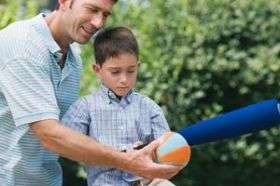Age-appropriate toys are the best choice, says expert

Many parents around the country will purchase toys for their children this holiday season. While choosing toys that will further a child's education development is important, it's also a great idea for parents to remember to play with their children and engage with them in their new gifts.
R. Keith Sawyer, Ph.D., associate professor of education in Arts & Sciences at Washington University in St. Louis, offers advice to parents worried about making the right toy choice for their children.
Sawyer is an expert on creativity and improvisation, which includes improvised play among children. He says toys can play an important role in a child's education and development, especially for children who haven't reached first grade yet.
"Most of the toys geared at children age six and younger are based on an educational theory known as constructivism," Sawyer says. "Constructivism is the idea that children create their own knowledge by actively participating in the learning process. Playing with toys — even something as simple as blocks — allows children to create their own play environment and stimulate their imagination."
Basically any kind of toy is good for young children as long as it is safe, of course, well-constructed and age appropriate, he says. "Parents can relax a little bit. There aren't really any bad toys or bad kinds of play. Because of my research on children's improvisation during fantasy play — which leads to all sorts of social and conversational advancement — I like to see pretend play that is more loosely structured and more improvisational."
Sawyer notes that toys that are "low realism" can improve a child's creativity and improvisational play skills. "Low realism refers to toys that are not likeness-based. For example, if you bought your child the toy cowboy from the movie "Toy Story," the child will probably already be familiar with the movie, with the character and how the character talks and acts. That narrows the range of pretend play options or scenarios the child will engage in. However, if you get your child a generic cowboy toy, the child might act out scenes from "Toy Story," but might also do something completely different."
Sawyer says that while low realism toys are generally better for more creative play, it also depends on the age of the child. "Younger children, those who are two or three years old, might need the extra realism in their toys because they aren't skilled enough yet to make up their own play scenarios."
And, according to Sawyer, it's not the toy itself that incites the learning process in a younger child, but the interaction between the child and the parents surrounding the toy. "Whatever toy you buy your child, don't just put her in a room with it and let her play with the toy by herself and think she's going to get anything out of it. The child will get the most benefit from parent/child interaction surrounding the toy or game."
For school-aged kids
For children who are in school — those who are six years old or older — Sawyer does recommend toys and games that are more education-based. Those might include chemistry sets, educational video games or board games that help them understand rules and strategy.
"If you want your child to be well-rounded, by all means buy her a chemistry set. Just don't try to teach your child specific subject matter with a toy before he or she is six years old," Sawyer stresses. "That's premature and you lose the potential for them to learn things like analytical thinking, cognitive ability and logical reasoning that are taught with more constructivist kinds of toys such as blocks and LEGOs or toy figures like dinosaurs and farm animals."
Video game systems have become popular for children of all ages and Sawyer says that they are not as bad as some parents might think. "Most of the research is actually pretty favorable for video games," Sawyer says. "The big difference between television and video games is that TV is passive while video games are active. While playing a video game, your child isn't physically interacting with what's on the screen, but his or her mind is very much engaged. Most video games are much better than watching television."
According to Sawyer, most research also shows that video games do not turn children into loners. "Games support a lot of social interaction between children. They tend to play video games with friends and when they are at school they brag about the highest level they've reached in a game."
The one down side to video games as far as creativity and improvisation are concerned, Sawyer maintains, is that video game worlds are much more constrained than reality. "If a child is playing a fantasy game with his friends, the options are unlimited. I think improvisation is very important for development. If a child was playing only video games he or she might lose the ability to improvise creatively."
Sawyer's number one recommendation when buying toys for children is to make sure they are age-appropriate. "Your child won't learn much from a game or toy that is too beneath him or too advanced. Make sure the toy challenges your child, but isn't too difficult or too easy."
Source: Washington University in St. Louis





















